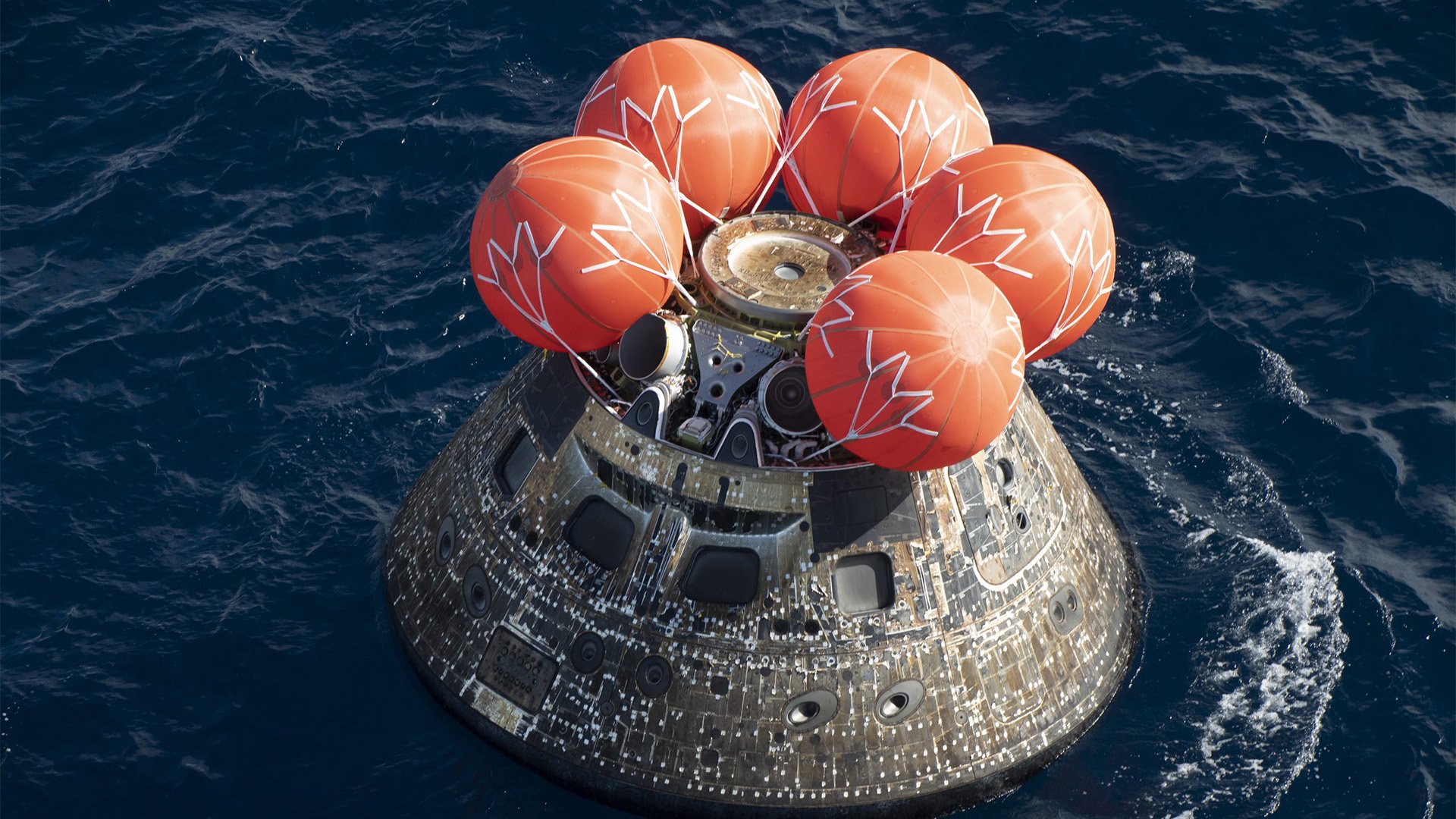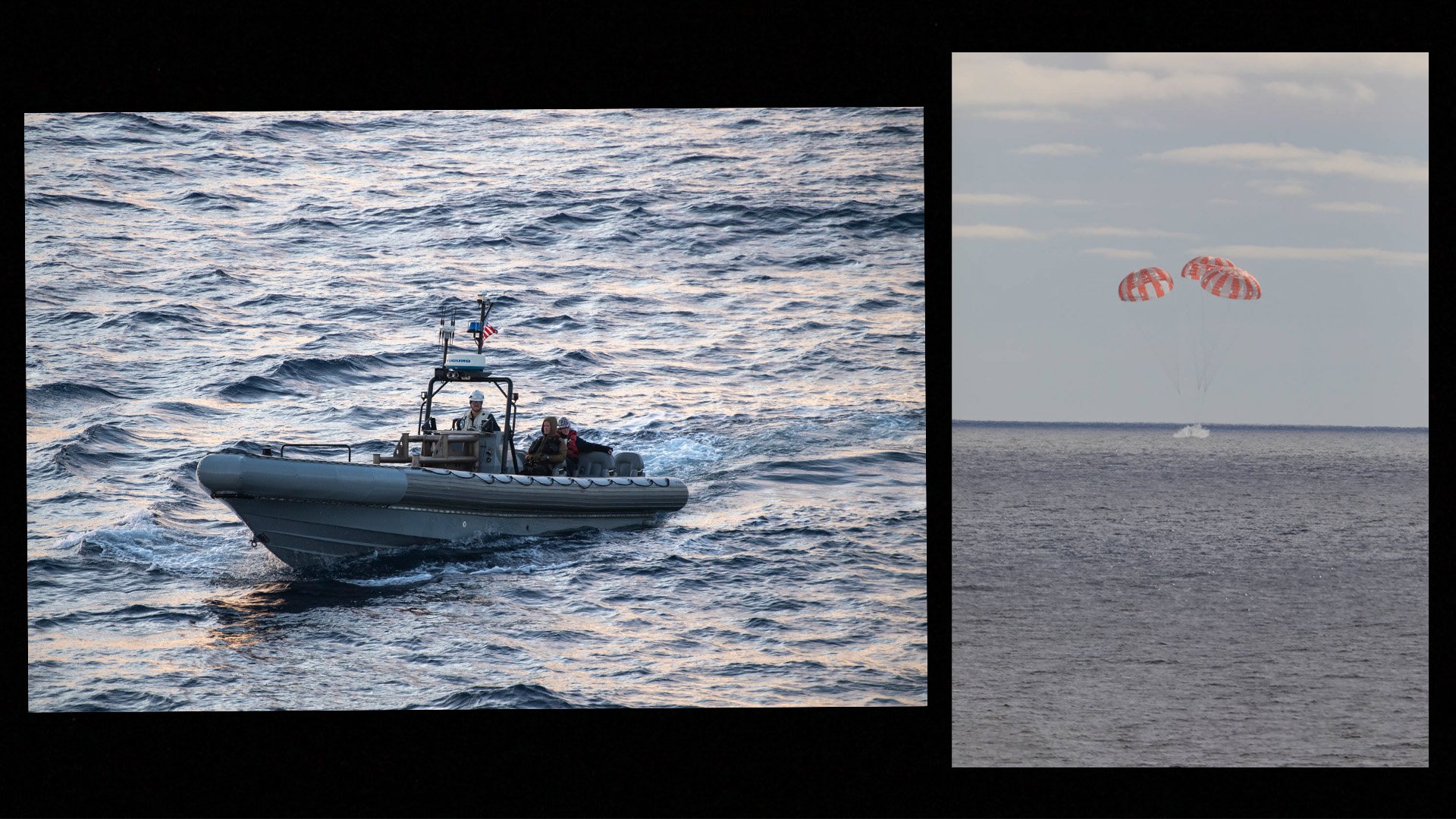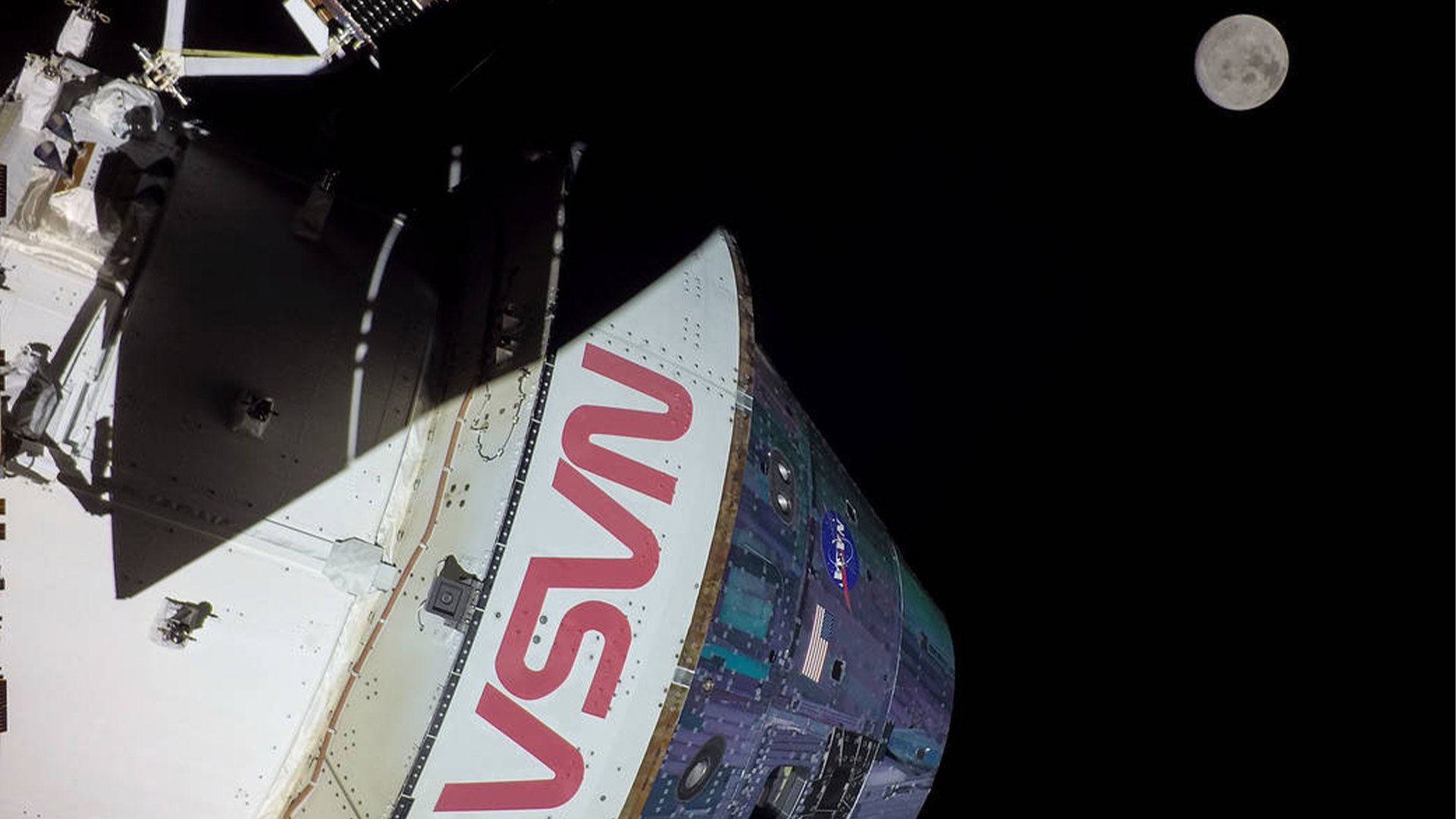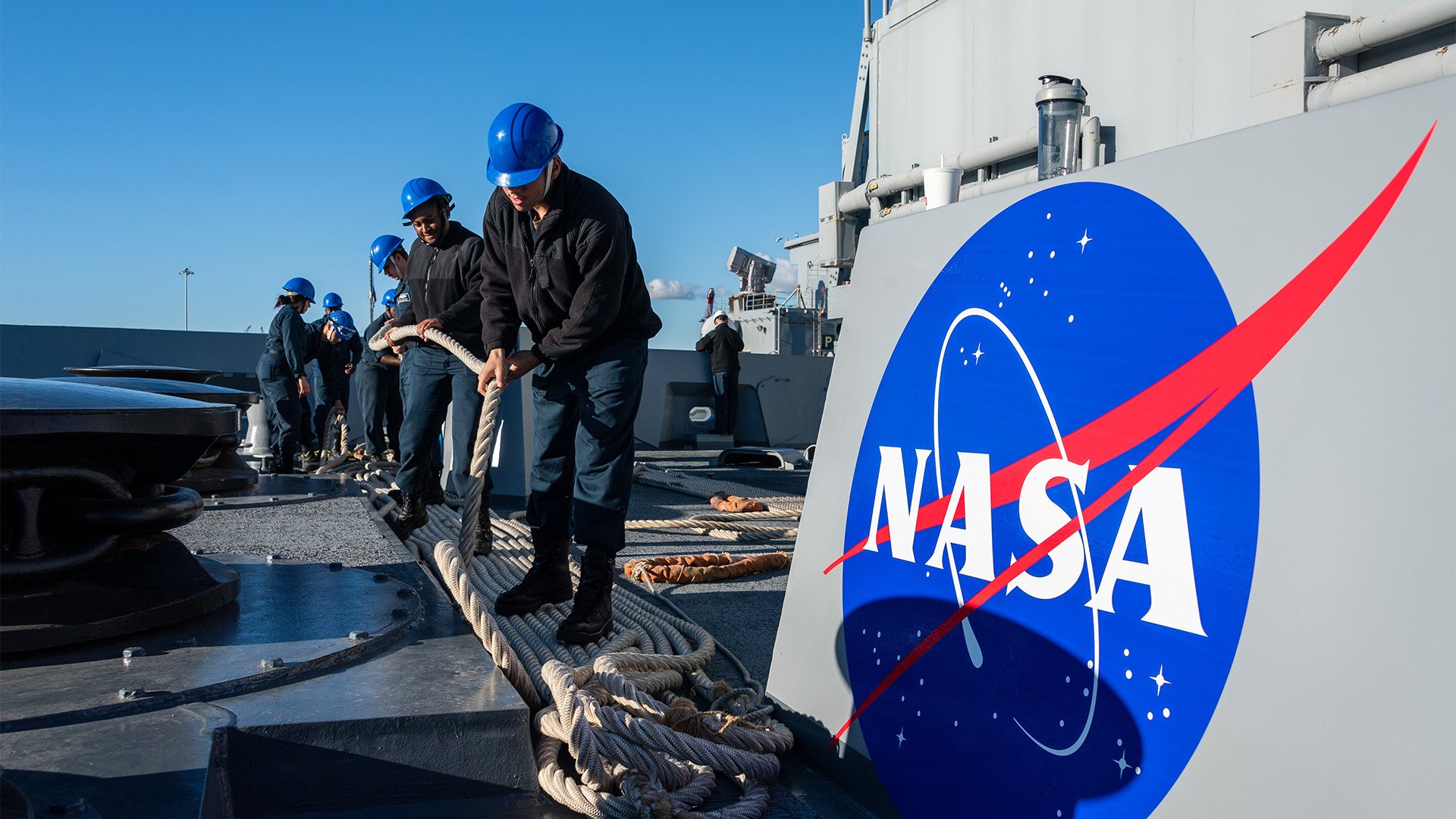
On Dec. 11, 2022, NASA’s Orion spacecraft for the Artemis I mission splashed down in the Pacific Ocean after a 25.5-day mission to the Moon. It was recovered and placed on a special cradle inside the well deck of the US Navy's amphibious warship Portland. NASA photo by James M. Blair.
The amphibious warship Portland is steaming for San Diego, a world-famous deep space traveler safely stowed in its well deck.
At 9:40 p.m. local time on Sunday, Dec. 11, NASA’s uncrewed Orion spacecraft’s parachutes unfurled inside Earth’s atmosphere and the module splashed down in the Pacific Ocean off the Baja California coast.
That capped a 25-day Artemis I mission that traveled 1.1 million nautical miles, from Kennedy Space Center in Florida and then a long swing around the moon and back to our planet.
“We followed the vehicle as it made its journey around the moon, and we held our breaths all morning because Orion went through its de-orbit and splashdown paces,” Janet E. Petro, the director of the John F. Kennedy Space Center, told reporters during a Sunday press conference. “It really was surreal.”
Portland is slated to arrive at US Naval Base San Diego on Tuesday, with crews scheduled to unload Orion two days later. The module will then begin its journey back to Florida.

Sailors from the amphibious transport dock Portland took to small boats, left, to prep for recovery of NASA's Orion spacecraft, which splashed down, right, in the Pacific Ocean off Baja California on Sunday, Dec. 11, 2022. Photos by Mass Communication Specialist 2nd Class Melvin Fatimehin and NASA.
NASA reported that mission control at Houston’s Johnson Space Center spent roughly two hours performing tests while the capsule bobbed in open water, downloading data about the spacecraft.
A key interest for researchers is how well Orion endured the blistering heat of reentry through Earth’s atmosphere — at around 5,000 degrees Fahrenheit, about half as hot as the sun's surface — which is why NASA ordered the recovery team to take many photos of the spacecraft.
Navy divers then attached a winch line and several tending lines to the module, and Portland’s crew began slowing heaving in the spacecraft before nestling it in the well deck’s specially designed cradle.
After ocean water drained from the well deck, Orion was secured for the journey to San Diego, which is going a lot slower than the spacecraft when it returned to Earth.
During its 20-minute plunge toward the Pacific, Orion was falling at nearly 22,000 knots.

On the 19th day of the Artemis I mission, Dec. 4, 2022, a camera mounted on the Orion spacecraft captured the moon just in frame as Orion prepared for its return powered flyby on Dec. 5, when it passed approximately 79 miles above the lunar surface. NASA photo.
But it hit the water at 17 knots. And Howard Hu, NASA’s program manager for the Artemis missions, said Orion splashed down only 2.1 nautical miles from its target.
That was 2.4 nautical miles closer than the space agency required, so he was happy.
The recovery team ranged from the sailors on board Portland to Space Force weather specialists, and engineers and technicians from Lockheed Martin Space Operations and NASA.
US 3rd Fleet announced the Independence-class littoral combat ship Montgomery supported Portland during the recovery operation.
NASA’s chief flight director, Emily Nelson, said Orion's odyssey had “exceeded all expectations,” which means her researchers can “start looking ahead at Artemis II, and thinking about how else we can push the boundaries on this flight.”

Sailors handle lines on the forecastle of the amphibious transport dock Portland while getting underway from San Diego on Dec. 7, 2022, to support the recovery of NASA’s Orion spacecraft. Portland was supported on the mission by the Independence-class littoral combat ship Montgomery. US Navy photo by Mass Communication Specialist 2nd Class Devin Kates.
Slated for mid-2024, the second flight of NASA’s Space Launch System will feature four RS-25 engines churning more than 2 million pounds of thrust to ferry three US astronauts and a Canadian crew member on a 10-day lunar flyby.
The crew is expected to be named in 2023.
Artemis III is intended to return astronauts to the lunar surface in 2025, with a journey to Mars launching closer to 2040, officials said.
“A lot of this will depend on the development of new technologies and the ability to sustain humans for a long time along the way,” NASA administrator Bill Nelson told reporters.
Read Next: Not Just an $858 Billion Bill on Capitol Hill: More Sailors, Pay Hike

Carl Prine is a former senior editor at Coffee or Die Magazine. He has worked at Navy Times, The San Diego Union-Tribune, and Pittsburgh Tribune-Review. He served in the Marine Corps and the Pennsylvania Army National Guard. His awards include the Joseph Galloway Award for Distinguished Reporting on the military, a first prize from Investigative Reporters & Editors, and the Combat Infantryman Badge.
BRCC and Bad Moon Print Press team up for an exclusive, limited-edition T-shirt design!
BRCC partners with Team Room Design for an exclusive T-shirt release!
Thirty Seconds Out has partnered with BRCC for an exclusive shirt design invoking the God of Winter.
Lucas O'Hara of Grizzly Forge has teamed up with BRCC for a badass, exclusive Shirt Club T-shirt design featuring his most popular knife and tiomahawk.
Coffee or Die sits down with one of the graphic designers behind Black Rifle Coffee's signature look and vibe.
Biden will award the Medal of Honor to a Vietnam War Army helicopter pilot who risked his life to save a reconnaissance team from almost certain death.
Ever wonder how much Jack Mandaville would f*ck sh*t up if he went back in time? The American Revolution didn't even see him coming.
A nearly 200-year-old West Point time capsule that at first appeared to yield little more than dust contains hidden treasure, the US Military Academy said.












